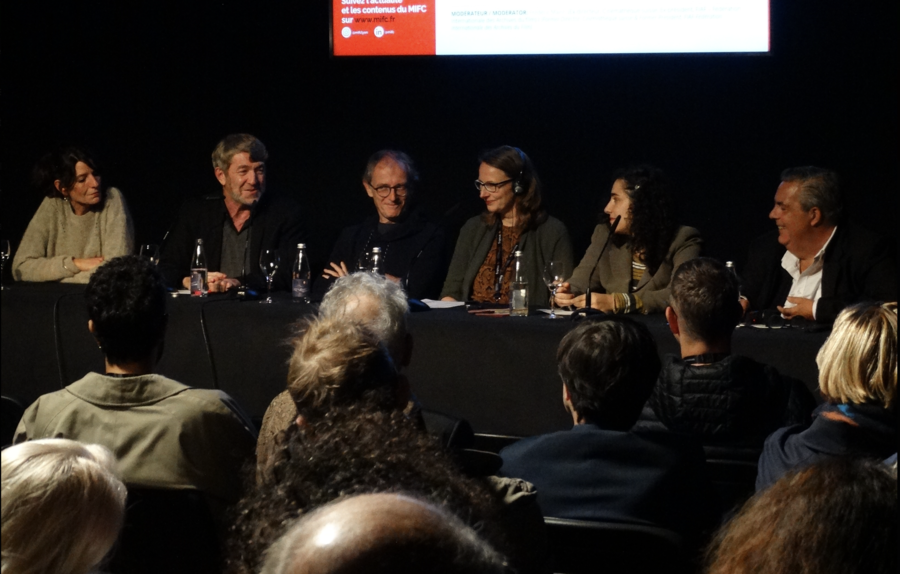Retrospectives: what path for the market? From restoration to distribution at the European level
This roundtable, moderated by Frédéric Maire (Former Director, Cinémathèque suisse, Former President, FIAF - International Federation of Film Archives), brought together Maelle Arnaud (Institut Lumière), Philippe Bober (Coproduction Office), Philippe Chevassu (Tamasa Distribution), Stefanie Eckert (DEFA-Stiftung), and Diana Santamaria (Atalante Cinema). The discussion focused on the different stages and challenges of exploiting heritage films, from restoration to distribution on a European scale.

The Catalytic Role of Festivals and Programming Strategies
Maelle Arnaud explained that the Lumière Festival uses three approaches for its retrospectives: turnkey proposals from specialized distributors (e.g., Konrad Wolf), cycles requiring assembly work from various rights holders (e.g., Louis Jouvet), and retrospectives initiated by the festival (e.g., Martin Ritt). The festival’s objective, with its 43 projection screens, is to serve as a launchpad for theatrical exploitation in France and abroad. For complex retrospectives, the festival pushes studios (especially American ones) to finance the production of subtitled DCPs to ensure the circulation of the works, an investment that subsequently benefits the entire distribution chain.
Restoration, Rights, and Funding Complexity
The DEFA-Stiftung (Stefanie Eckert), which holds all the rights to thousands of films from the former German Democratic Republic, has a specific economic model: the commercial success of flagship films (e.g., Solo Sunny) funds the restoration of other works. The restoration and digitalization process (700 films restored to date) often takes two years and is guided by commercial urgency or material degradation, before purely cultural interest. Internationally, the timeline for classics is pluridecennial. Philippe Bober (Coproduction Office) emphasized that, while wealthy countries (like Germany and France) have public funds (CNC, German Fund) to support the restoration of national heritage, international buyers and sellers must often self-finance the restoration of films from less well-endowed countries, recovering that investment over the long term through international sales. The complexity of rights, particularly for co-productions or works with multiple heirs, remains a major obstacle.
Exploitation Strategies in Various Markets Distributors adapt their strategy according to the markets.
-
In France (Philippe Chevassu/Tamasa): The support of the CNC and the coordination between different media (theatres, festivals, video, TV) are major assets. Tamasa's strategy includes providing promotional tools (unitary posters, trailers) to foreign distributors to help them market the films without excessive additional costs.
-
In Spain (Diana Santamaria/Atalante Cinema): The market for heritage films in cinemas is minority and unsystematic, with limited public support. Atalante uses key events (e.g., the centenary of Maurice Pialat) to launch retrospectives (10 films). The tactic is to give a more ambitious commercial release to a "headliner" film (e.g., À nos amours) to generate visibility for the entire cycle. The films are commercialized over the very long term (7 to 10-year contracts) to ensure the return on investment, using non-commercial networks (cine-clubs, cinematheques) in addition to VOD/TV platforms. The editorial effort (creation of new visual materials and thematic content) is fundamental to modernizing the image of the classics.
Key Points and Common Challenges
-
The Festival as a Trigger: The Lumière Festival, as well as other festivals like Bologna or La Rochelle, are essential launchpads for theatrical exploitation and international visibility.
-
The Digital Imperative: The creation of digital material (DCP) is an essential prerequisite for the current circulation of films.
-
Sales as a Subsidy: The commercial appeal of the most famous films (e.g., Solo Sunny, À nos amours) serves as a lever to finance the restoration and distribution of lesser-known works by the same director or from the same catalogue.
-
Complexity of Rights: International law, particularly for co-productions, and the difficulty in locating rights holders require persistent determination from distributors.
-
Long-Term Vision: The recovery of investment happens over the very long term (up to 10 years), by multiplying exploitation windows (theatres, video, TV, non-commercial).
-
Creative Valorization: The creation of "sexy" and contemporary promotional material (posters, trailers) is crucial for revitalizing the image of heritage cinema and reaching a new audience.




